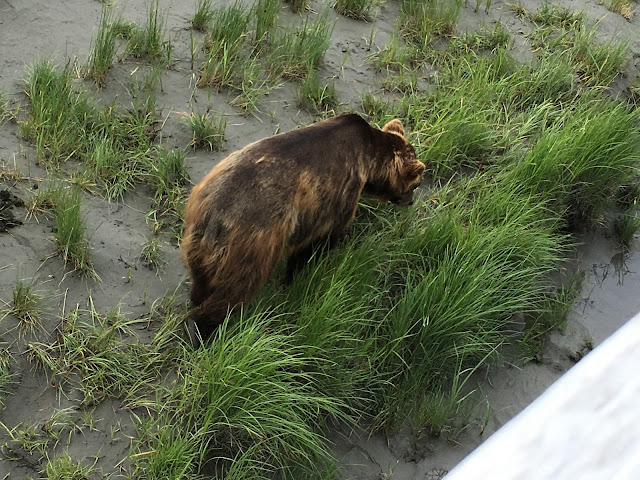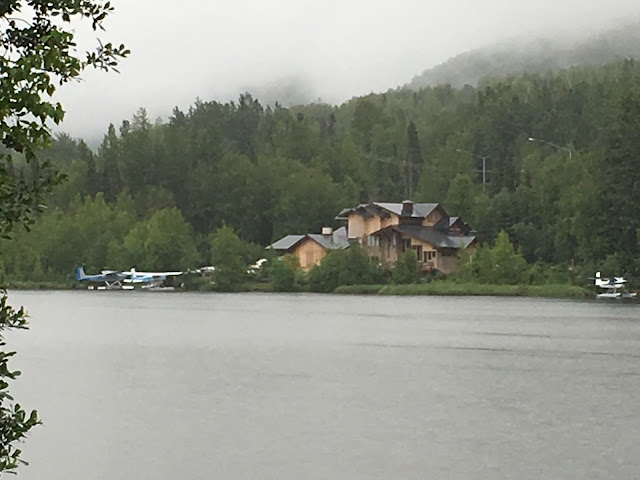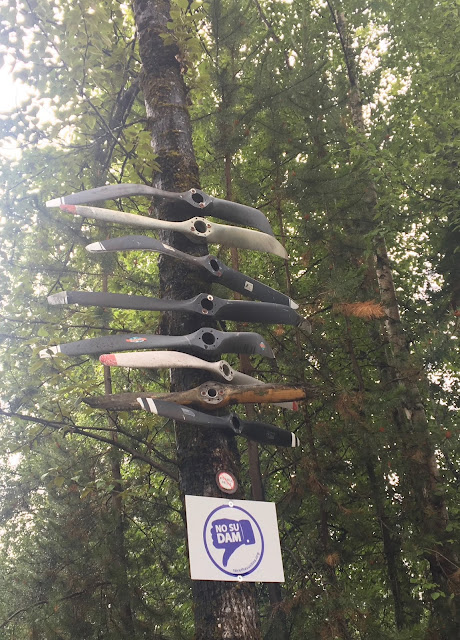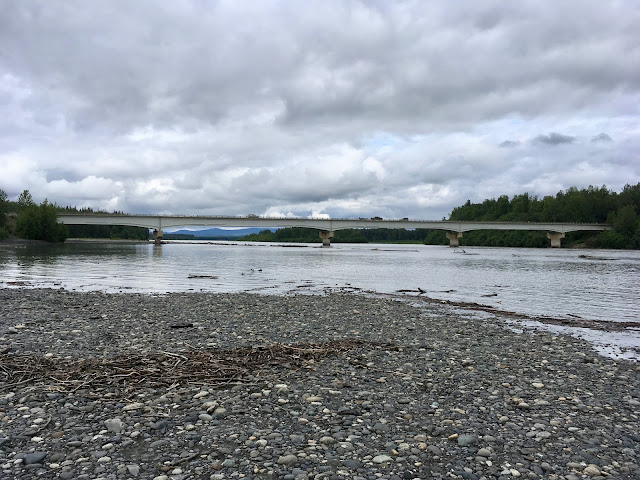Alaska/Canada 2017 - 2: Driving North on the Parks Highway
Our first whole day on Alaskan soil was the beginning of the Fourth of July weekend, so we decided it might be wise to stay a second night on Turnagain Arm.
When the Russians reached this area from what is today the Gulf of Alaska and found the body of water had not outlet, they called it “Return.” In 1778, when he realized it was not the long sought Northwest Passage, Captain Cook named it “Turnagain River.” In 1794, Captain Vancouver, not to be outdone, named it Turnagain Arm, and the name stuck.
Campsite secured, we drove south on Turnagain Arm to the Alaska Wildlife Conservation Center (AWCC).
We spent a couple of hours walking the grounds of this amazing animal park. Some animals were orphaned while young and will live out their lives at AWCC, while others are recuperating from injuries.
AWCC has an amazing program for wood bison (different from plains bison of the lower 48), which were thought to be extinct for over a century. When some were discovered in the Yukon, they were brought to the center, which breeds them and reintroduces them into the wild.
Humans were training a porcupine, which was in turn was training the humans.
AWCC was a terrific introduction to Alaska's wildlife, despite the rain and mud.
Doug met a couple of women on the ferry who had survived the 1964 earthquake and tsunami, and he wanted to visit the site of Portage, one of the towns destroyed by the event. Once a major railroad stop, all that remains of Portage today are a couple of dilapidated buildings.
We continued on Portage Glacier Road to the Begich, Boggs Visitor Center at the west end of the Whittier Tunnel we'd driven through the day before after debarking the ferry. The center highlights the natural and cultural history of Chugach National Forest. The center's clear floor gives the disconcerting feeling you are on Portage Lake below. Outside in the wind and rain, I felt as cold as the blue glacial waters of Whittier Creek.
The next day, we had lunch in Anchorage with friends from home who were visiting family. We hung around Anchorage for the weekend, checking out Title Wave Used Books, where we found a few books for the upcoming adventure, and trying out some cafes.
Well, we’d just had breakfast, so we weren’t hungry, but we did enjoy a Chuli Stout (Doug) and a Twister Creek IPA (Marilyn) under a patio umbrella in the rain at Twister Creek Restaurant, home of the Denali Brewing Company.

Looking out on rainy Talkeetna from the Twister Creek Patio.
Back on the Parks Highway pointing north, we hadn’t gone far when crossing the bridge over the Susitna River, we noted RVs parked far below on the river’s flat gravel bar.
Soon we too were settled at a free campsite 20 or so yards from the water and went strolling along the river. We chatted with a young family from Palmer, where Marilyn's brother-in-law David grew up, his dad being the town doctor. As is typical of small town, they knew his dad. It was lovely to not be in a hurry, to sit and look at the forest and the Susitna River rolling by.
Around 11:00 PM and still daylight, we were snuggled in our sleeping bag when several pickups pulled up to the water in front of us. Out spilled adults, kids, a BBQ, tables, and chairs. They proceeded to have a grand old time, including setting off all kinds of fireworks, until about 2:00 AM, when they apparently returned home. Who needs to sleep when it’s still light?
Some Hooptedoodle: For those of you who have been following the saga of our quest for a name for the Traverse, even generously suggesting ideas, the search is over! She is Bobbie Bleue McGee. Ask Doug, and he will attempt to explain the literary significance, including reference to JD McDonald's Travis McGee and Kris Kristofferson’s "Bobby McGee." It truly is a stretch.
Alaska Railroad running along Turnagain Arm.
When the Russians reached this area from what is today the Gulf of Alaska and found the body of water had not outlet, they called it “Return.” In 1778, when he realized it was not the long sought Northwest Passage, Captain Cook named it “Turnagain River.” In 1794, Captain Vancouver, not to be outdone, named it Turnagain Arm, and the name stuck.
Turnagain Arm.
We decided to camp another night at Bird Creek, which turned out to be a very good decision, though we didn't know it at the time. The next morning a young barrista at Ollin Tea and Cafe, a native of Seward on the tip of the Kenai Peninsula, toldl us the southbound bumper-to-bumper traffic we'd watched from our Bird Creek campsite Friday night was due to the annual July 4 festival and Mount Marathon Race in Seward. Said to have begun on a bar bet, the race is a roundtrip run from sea level to a 3,ooo-foot peak. We were pleased that in our naiveté we had elected to visit Seward at a later date. Bird Creek Campground, Turnagain Arm.
Campsite secured, we drove south on Turnagain Arm to the Alaska Wildlife Conservation Center (AWCC).
We spent a couple of hours walking the grounds of this amazing animal park. Some animals were orphaned while young and will live out their lives at AWCC, while others are recuperating from injuries.
Alaska Wildlife Conservation Center (AWCC).
AWCC has an amazing program for wood bison (different from plains bison of the lower 48), which were thought to be extinct for over a century. When some were discovered in the Yukon, they were brought to the center, which breeds them and reintroduces them into the wild.
Wood bison.
Black-tailed Sitka deer.
Grizzly bear, distinguishable by the hump between its shoulders.
Musk ox.
Baby moose.
I always thought Bullwinkle was a caricature, but it turns out moose really do have long snouts, which they use for feeding in ponds, where they get most of their nourishment.
Humans were training a porcupine, which was in turn was training the humans.
Porcupine & human in training.
Reindeer.
AWCC was a terrific introduction to Alaska's wildlife, despite the rain and mud.
Doug at AWCC.
Doug met a couple of women on the ferry who had survived the 1964 earthquake and tsunami, and he wanted to visit the site of Portage, one of the towns destroyed by the event. Once a major railroad stop, all that remains of Portage today are a couple of dilapidated buildings.
Portage today.
Whittier Creek & west end of Whittier Tunnel.
Joint Base Elmendorf/Richardson (JBER) on the north end of Anchorage was our home Saturday night, another benefit we are able to enjoy because of Doug’s Naval Aviator career. We did laundry and showered twice, that night and in the morning--you never know when the next shower will be when you're on the road!
Sunday afternoon, we headed north on Alaska 1, the Glenn Highway, which soon turned east. We continued on 3, the Parks Highway. Alaska has four main highways: 1, 2, 3, and 4. There are also 5 through 11 and 98, the Klondike Highway, named for the 1898 Gold Rush. Roads connect only a small portion of the state. To go most places, you need a boat or, more often, a plane. The picture below is not an unusual scene.
In Wasilla, we bought supplies, then ventured west to see what we would find.
We soon found Lucile Lake County Park, where the host quickly informed us that Sarah Palin lived across the lake and told us how to locate her house.
After settling into a site, we headed for the dock. One of the benefits of travel is meeting folks, and there we chatted with a couple from western North Carolina. They were making the entire roundtrip in their Roadtrek 190—no ferry. We would run into them again and continue our chat the next day.
As we looked across the lake from the dock, sure enough, four houses down from the Best Western, was Palin's house with a vacant lot to the left and the infamous 14-foot spite wall.
The late Joe McGinniss, a reporter for the Washington Post, the house next to Palin to gather information for the book he would pen, The Rogue: Searching for the Real Sarah Palin. When he vacated the house, Palin bought it, razed it, and had the wall built.
What we didn't see from the dock was Russia—just calm water reflecting the clouds and the mountains across that reached up into the fog.
Despite the rain, we popped the van’s top and pulled out the awning, the second time this trip, which is more than we’d used the awning in the ten years since we bought it for our VW Westy. An aside: about three years ago our friends Jerry and Susan borrowed our awning when they took their VW Westy to Alaska, and I think they used it once the entire trip.
When rain pooled in the awning, we interrupted our reading and hot chocolate to lower the pole on one side and create a waterfall.
Monday morning after coffee, oatmeal, and a book, we undertook the daily attempt to get the Traverse into a semblance of order—shuffling and reshuffling. We didn’t bring too much food this time, but we did bring too many clothes and some things sneaked in that were supposed to be left at home. All in all, though, it is a comfy home away from home and a great way to see the country.
We were off north again, when I noticed sled dogs pulling an ATV alongside the highway. I texted my sister, a big Idatarod fan, and her husband, who is from Alaska, and learned that this is typical summer training: the musher throws the ATV into neutral, and off they go!
Travel by sled and sled dogs is another option along with boats and planes for travel in Alaska.
JBER Family Camp.
Sunday afternoon, we headed north on Alaska 1, the Glenn Highway, which soon turned east. We continued on 3, the Parks Highway. Alaska has four main highways: 1, 2, 3, and 4. There are also 5 through 11 and 98, the Klondike Highway, named for the 1898 Gold Rush. Roads connect only a small portion of the state. To go most places, you need a boat or, more often, a plane. The picture below is not an unusual scene.
Transportation on Eagle River.
Transportation parked beside the house.
In Wasilla, we bought supplies, then ventured west to see what we would find.
We soon found Lucile Lake County Park, where the host quickly informed us that Sarah Palin lived across the lake and told us how to locate her house.
After settling into a site, we headed for the dock. One of the benefits of travel is meeting folks, and there we chatted with a couple from western North Carolina. They were making the entire roundtrip in their Roadtrek 190—no ferry. We would run into them again and continue our chat the next day.
As we looked across the lake from the dock, sure enough, four houses down from the Best Western, was Palin's house with a vacant lot to the left and the infamous 14-foot spite wall.
Sarah Palin's house, with vacant lot and wall next door.
What we didn't see from the dock was Russia—just calm water reflecting the clouds and the mountains across that reached up into the fog.
The awning is like having another room.
When rain pooled in the awning, we interrupted our reading and hot chocolate to lower the pole on one side and create a waterfall.
Monday morning after coffee, oatmeal, and a book, we undertook the daily attempt to get the Traverse into a semblance of order—shuffling and reshuffling. We didn’t bring too much food this time, but we did bring too many clothes and some things sneaked in that were supposed to be left at home. All in all, though, it is a comfy home away from home and a great way to see the country.
We were off north again, when I noticed sled dogs pulling an ATV alongside the highway. I texted my sister, a big Idatarod fan, and her husband, who is from Alaska, and learned that this is typical summer training: the musher throws the ATV into neutral, and off they go!
Travel by sled and sled dogs is another option along with boats and planes for travel in Alaska.
There are airports and landing strips everywhere in Alaska--much of it is only reachable by plane.
We took the spur road to Talkeetna and stopped at the Flying Squirrel Cafe—remember Rocky and Bullwinkle?—which provided dry warmth on another rainy, chilly day. After Doug’s very healthy rice, bean, and kale burrito and my not as healthy “fancy grilled cheese” on scrumptious bread, we departed back into the rain, taking along an olive oil baguette, so good we could have eaten all of it at once.
Talkeetna is the jumping off point for flying to Denali, whether to scale the mountain or just experience landing on a glacier. We weren’t doing either, and from the looks of it, neither were most of the tourists crowding the streets.
The rain also meant that there would be none of Talkeetna’s famed views of Denali. In the art show near the banks of the Talkeetna River that flows by the town, we bought a photo of Denali.
The photographer had conveniently hung the same photo, with the peaks labeled, in front of his stall. He told us that Talkeetna means the “place where three rivers meet”: the Talkeetna, the Susitna, and the Chulita.
Grass airstrip in Talkeetna.
Talkeetna Airport.
The rain also meant that there would be none of Talkeetna’s famed views of Denali. In the art show near the banks of the Talkeetna River that flows by the town, we bought a photo of Denali.
The photographer had conveniently hung the same photo, with the peaks labeled, in front of his stall. He told us that Talkeetna means the “place where three rivers meet”: the Talkeetna, the Susitna, and the Chulita.
None of the other tourist shops calling to us, Doug commented, “It’s after 12.”
Well, we’d just had breakfast, so we weren’t hungry, but we did enjoy a Chuli Stout (Doug) and a Twister Creek IPA (Marilyn) under a patio umbrella in the rain at Twister Creek Restaurant, home of the Denali Brewing Company.

Looking out on rainy Talkeetna from the Twister Creek Patio.
Note the many bent propellers hanging on this tree. For each there is no doubt a story of a rather eventful landing.
Back on the Parks Highway pointing north, we hadn’t gone far when crossing the bridge over the Susitna River, we noted RVs parked far below on the river’s flat gravel bar.
Susitna River.
Boondocking on the Susitna River—with the awning deployed yet again!
Soon we too were settled at a free campsite 20 or so yards from the water and went strolling along the river. We chatted with a young family from Palmer, where Marilyn's brother-in-law David grew up, his dad being the town doctor. As is typical of small town, they knew his dad. It was lovely to not be in a hurry, to sit and look at the forest and the Susitna River rolling by.
Still light at 11:00 PM & time to get the July 4 celebration started!
Around 11:00 PM and still daylight, we were snuggled in our sleeping bag when several pickups pulled up to the water in front of us. Out spilled adults, kids, a BBQ, tables, and chairs. They proceeded to have a grand old time, including setting off all kinds of fireworks, until about 2:00 AM, when they apparently returned home. Who needs to sleep when it’s still light?
Bridge over Susitna River.
Some Hooptedoodle: For those of you who have been following the saga of our quest for a name for the Traverse, even generously suggesting ideas, the search is over! She is Bobbie Bleue McGee. Ask Doug, and he will attempt to explain the literary significance, including reference to JD McDonald's Travis McGee and Kris Kristofferson’s "Bobby McGee." It truly is a stretch.
2023 update: The Traverse eventually became Ms Agnes, which she remains today with her new owners.
Next up: On to Fairbanks and the Land of the Midnight Sun.
Next up: On to Fairbanks and the Land of the Midnight Sun.




.heic)








.heic)




























Great photos of the critters at the AWCC! It's good they have a safe place. And I chuckled at the memory of everyone's favorite Wasilla resident. How was the Twister Creek IPA?
ReplyDeleteAlmost all IPAs are good:-)
Delete